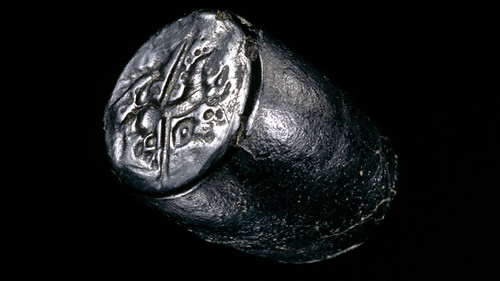
PREV ARTICLE
NEXT ARTICLE
FULL ISSUE
PREV FULL ISSUE
THE DIE THAT STRUCK BRITAIN’S FIRST COINS?Arthur Shippee forwarded this British Museum
blog article about a die that may have struck some of
Britain's earlier coins. Thanks! -Editor
  One of the most recent acquisitions made by the Department of Coins and Medals is a highly unusual object – an ancient punch or ‘die’ used to manufacture coins in the second century BC. The die was found in Bredgar, Kent by a metal detector user in 2013 and is being used to shed new light on when the first coins were made in Britain. The earliest coins found in Iron Age Britain date from around the second century BC and, until recently, it was believed that they were produced in Gaul (a region roughly equivalent to modern day France and Belgium) and imported into south-east England. These coins, known as Gallo Belgic A, were based on the gold coinage (staters) issued by King Philip II, ruler of the Greek kingdom of Macedon from 359 – 336 BC and father of Alexander the Great. Philip’s coin shows a representation of the god Apollo on one side and a chariot drawn by two horses on the other. Iron Age coins derived from these staters carry abstract versions of these images. The hair and laurel wreath on the image of Apollo, for example, are much exaggerated. Similarly, the image of the horse on the reverse of the coin has been stylised and is reminiscent of the Prehistoric chalk horses found on the hillsides of Britain, such as the one at Uffington. Close examination of the coin die revealed that it was used in the production of the early Gallo-Belgic A coins. What this means is that, although it is the third Iron Age coin die to be found in the UK (the others are also in the British Museum), it is almost certainly the earliest. The most significant aspect of this discovery is the fact that it is a British find. This raises the intriguing possibility that the earliest known coins from Britain were actually made here and not just imports from the Continent. Around 250 Gallo-Belgic A coins are known from Britain and France, but unfortunately the new die cannot be linked to any of them. This fact has been used to suggest that it may have been a forger’s die. In reality, however, we can read very little into the fact that we do not have an example of a coin struck using this die. Little is known about the mechanics of coin production in the Iron Age and, in particular, about the authorities that produced them. The distinction between an ‘official’ and a ‘forger’s’ die may not be have been relevant in Iron Age society. A programme of scientific analysis will tell us more about how the die was made and used, but its precise origins are likely to remain a mystery. The die is on display in the Citi Money Gallery. To read the complete article, see: The die that struck Britain’s first coins? (blog.britishmuseum.org/2014/04/11/the-die-that-struck-britains-first-coins/) Wayne Homren, Editor The Numismatic Bibliomania Society is a non-profit organization promoting numismatic literature. See our web site at coinbooks.org. To submit items for publication in The E-Sylum, write to the Editor at this address: whomren@gmail.com To subscribe go to: https://my.binhost.com/lists/listinfo/esylum All Rights Reserved. NBS Home Page Contact the NBS webmaster 
|